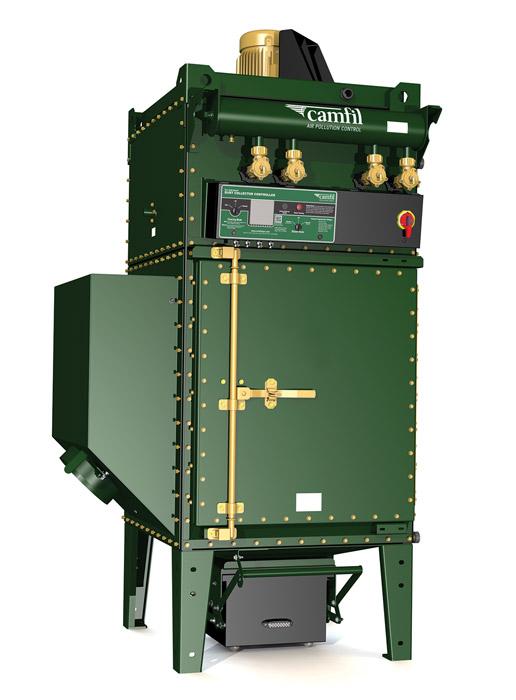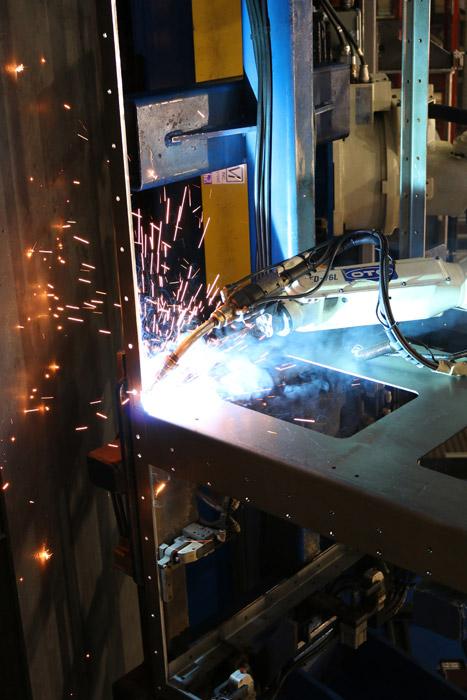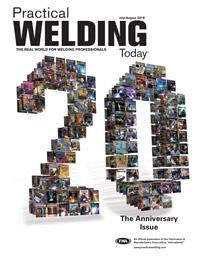Metalworking Market Specialist
- FMA
- The Fabricator
- FABTECH
- Canadian Metalworking
Categories
- Additive Manufacturing
- Aluminum Welding
- Arc Welding
- Assembly and Joining
- Automation and Robotics
- Bending and Forming
- Consumables
- Cutting and Weld Prep
- Electric Vehicles
- En Español
- Finishing
- Hydroforming
- Laser Cutting
- Laser Welding
- Machining
- Manufacturing Software
- Materials Handling
- Metals/Materials
- Oxyfuel Cutting
- Plasma Cutting
- Power Tools
- Punching and Other Holemaking
- Roll Forming
- Safety
- Sawing
- Shearing
- Shop Management
- Testing and Measuring
- Tube and Pipe Fabrication
- Tube and Pipe Production
- Waterjet Cutting
Industry Directory
Webcasts
Podcasts
FAB 40
Advertise
Subscribe
Account Login
Search
Robotic welding fume capture 101
Staying on top of air quality in heavy robotic welding environments
- By Josh Delson
- July 21, 2016
- Article
- Safety
In recent years the advent of pre-engineered weld cell packages has made robotic equipment more affordable to manufacturers. Installing robots in facilities of all sizes can boost productivity by increasing weld speed, quality, and efficiency; reducing cycle time; and allowing a single operator to fixture the next piece while the robot welds. As production volume increases, however, so does the level of fume being generated.
The Robotic Industries Association reports that robot orders and shipments set new records in 2015, with an estimated 260,000 robots now operating in North American factories. If you are joining in on the trend, it may be time to reassess the fume collection requirements for your facility. It’s best to make this part of the planning process before you install robots. If you wait until weld cells are already in place, installing the collector can be problematic. It is always better to engineer the fume removal equipment in advance for the space and the application.
Many robotic integrators simplify this task by offering packaged fume collection that is integrated into the robotic system as a purchase option, making the process seamless and ensuring that the collector will be sized appropriately for the cell. But many times, it is the end user’s responsibility to find the right fume collection system.
If you already have a high-efficiency fume collector in place, you may be able to add on to this system, but only if it has a modular design that allows you to increase capacity with additional filtration modules. If the collector has a welded construction, the size is fixed, and you will likely need to replace it with a larger collector or add another collector.
Sizing Fume Collection Equipment for Robotic Applications
Capturing dust and fumes generated during robotic welding presents a unique challenge. Floor space is often very tight in areas where robotic cells are installed. Fume collection equipment size traditionally has been based on guidelines contained in the American Conference of Governmental Industrial Hygienists’ (ACGIH) Industrial Ventilation: A Manual of Recommended Practice. But airflow requirements under these guidelines are quite high, averaging 100 feet per minute (FPM) per square foot of hood opening. In robotic applications, this can result in a fume collector that is unnecessarily large and costly.
A more cost-effective strategy is to use the smallest possible collector to capture dust and fumes from the process while still meeting stringent air quality goals. To satisfy safety concerns, a robotic weld cell is designed as a relatively enclosed box. If you measure the cubic footage of the cell, calculate the volume of air inside, and then calculate the size of the collector according to the rate of air exchanges needed, you may be able to downsize.
How do you determine the correct rate of air exchanges? The answer depends on several factors. First, on systems with indexing walls, you must clear airborne contaminants from the box before the wall spins around on its axis; otherwise, the rotating wall will propel smoke and fumes toward the operator. The type of material being welded will also affect sizing. Welding galvanized steel, for instance, is of greater concern because it is an inherently smokier process. An experienced air filtration/fume collection supplier can help you with the calculation.
This method of calculating fume collector sizes for robotic weld cells will result in a lower upfront cost and smaller footprint. Energy savings are another benefit, since a smaller collector has lower fan horsepower requirements that in turn reduce electrical consumption.
Determining the Right Filtration Efficiency
The Occupational Safety and Health Administration (OSHA) has established permissible exposure limits (PELs) based on 8-hour time-weighted average (TWA) for hundreds of dusts, including the numerous metals contained in welding fumes. For further information, a good starting point is the OSHA Fact Sheet, “Controlling Hazardous Fume and Gases during Welding.”
It is imperative to know and comply with OSHA exposure limits for whatever materials you are welding, particularly where workers are at risk for long-term health effects. The OSHA PEL requirements will determine the minimum level of filtration efficiency that your fume collector must be able to achieve. But sometimes people get sick and experience headaches, upper respiratory symptoms, or general discomfort even when a facility is in compliance with OSHA. When this happens, you may need to set even lower exposure limits to eliminate employee complaints.

A safety monitoring filter or afterfilter provides added filtration and backup protection when hazardous fumes are being handled or filtered air is being recirculated for energy savings.
Emissions testing using air sampling techniques is often performed to determine what pollutants are occurring and ensure that a shop’s indoor air quality complies with OSHA regulations. Why is testing so important? Overexposure to weld fumes can cause a wide range of health problems.
One of the most serious offenders is hexavalent chromium, or hex chrome, a carcinogenic substance produced during welding of stainless steel and other metals that contain chromium. Hex chrome overexposure can result in short-term upper respiratory symptoms and eye or skin irritations. Long term, the greatest health danger associated with hex chrome exposure is lung cancer. Other major health effects include damage to the upper respiratory system; allergic and irritant contact dermatitis; and injury to the eyes, skin, liver, and kidneys. Because of the severe health risks, the OSHA PEL for hex chrome is extremely stringent, at just 5.0 micrograms per cubic meter TWA.
Zinc oxide is another harmful pollutant generated by hot work on galvanized steel. Exposure can result in a condition known as “metal fume fever,” a short-term illness in which severe flu-like symptoms occur after a break from work, such as after a weekend or during a vacation. Due to the delayed reaction, it is often confused with regular influenza, and many cases go undiagnosed.
In hazardous applications, the fume collector may require high-efficiency particulate arrestance (HEPA) safety monitoring filters (also called afterfilters) for added filtration and backup protection. Safety monitoring filters are also recommended if you opt to recirculate the filtered air instead of exhausting it outside. Air recirculation is the single best way to save energy and maximize return on investment with a fume collector. When you recirculate heated air back through the plant instead of venting it outdoors, the cost to replace that conditioned air is eliminated. Facilities report five- to six-figure annual energy savings with air recirculation.
Filter-Mounting Configuration
The mounting configuration of the filter cartridges in the collector can have a major impact on filter performance and life. Some fume collectors have horizontally mounted cartridges that can allow dust to become embedded on the top of the filters. This condition can shorten filter life and provide a dusty surface for sparks to ignite. Vertical mounting, by contrast, reduces the load on the filters and helps improve service life while reducing fire and explosion risks.
Exhausting Air Outdoors
In the past, when weld fumes became excessive, the simple solution was to open the shop door and exhaust fumes outside. Today, if fumes are exhausted outdoors, the air is subject to stringent monitoring under EPA National Emission Standards for Hazardous Air Pollutants (NESHAP), Rule 6X, which became effective in 2011. This standard addresses materials that contain 0.1 percent by weight cadmium, chromium, lead, or nickel; or 1.0 percent by weight manganese. Manganese is the material of widest concern to the welding industry, as it is virtually a universal component of welding wire and is consumed in large quantities in robotic welding.
Under these EPA guidelines, if you opt to exhaust the air straight outdoors, you must take an EPA Method 22 fugitive emissions test. Method 22, which is conducted to provide a visual determination of fugitive emissions from material sources, is performed by a trained observer who monitors an exhaust stack during a 15-minute timed test. If opacity—defined as the quality of a particle that makes it impervious to light—is observed during 20 percent or more of the test (i.e., three minutes), Rule 6X applies. Involving an environmental engineering consultant is recommended to conduct the Method 22 test and provide third-party confirmation of whether a facility is in compliance.
If Rule 6X applies and you fail the Method 22 test, you must:
- Notify the EPA.
- Tier 1 response: Change the process to eliminate the hazardous air pollutants. This might be accomplished by experimenting with different materials and/or different settings to reduce emissions. Whatever changes you make, equipment must always be operated in accordance with the manufacturer’s instructions.
- Conduct another Method 22 emissions test.
- Tier 2 response: If the second test fails, “Corrective action must take place immediately after the failed Method 22 test” per the Federal Register, page 42985, Welding compliance, Tier 2.
You can avoid the stringent requirements of Rule 6X by recirculating the air indoors, downstream of the dust collector. But as noted, under this strategy you will need to keep below OSHA exposure limits for whatever metal contaminants are generated.
If you follow correct procedures for design, sizing, and selection, your fume collector will effectively contain smoke and fumes from robotic weld cells, keeping employees safe while boosting morale, productivity, and reliability. When you add recirculation to the equation, you achieve the trifecta of compliance, wellness, and energy savings.
About the Author
About the Publication
subscribe now

The Welder, formerly known as Practical Welding Today, is a showcase of the real people who make the products we use and work with every day. This magazine has served the welding community in North America well for more than 20 years.
start your free subscription- Stay connected from anywhere

Easily access valuable industry resources now with full access to the digital edition of The Fabricator.

Easily access valuable industry resources now with full access to the digital edition of The Welder.

Easily access valuable industry resources now with full access to the digital edition of The Tube and Pipe Journal.
- Podcasting
- Podcast:
- The Fabricator Podcast
- Published:
- 04/16/2024
- Running Time:
- 63:29
In this episode of The Fabricator Podcast, Caleb Chamberlain, co-founder and CEO of OSH Cut, discusses his company’s...
- Trending Articles
Sheffield Forgemasters makes global leap in welding technology

ESAB unveils Texas facility renovation

Engine-driven welding machines include integrated air compressors

How welders can stay safe during grinding

The impact of sine and square waves in aluminum AC welding, Part I

- Industry Events
16th Annual Safety Conference
- April 30 - May 1, 2024
- Elgin,
Pipe and Tube Conference
- May 21 - 22, 2024
- Omaha, NE
World-Class Roll Forming Workshop
- June 5 - 6, 2024
- Louisville, KY
Advanced Laser Application Workshop
- June 25 - 27, 2024
- Novi, MI



























